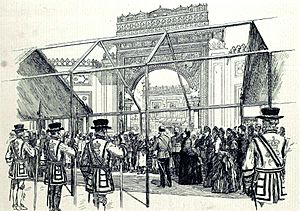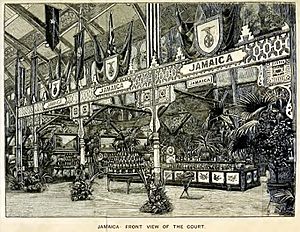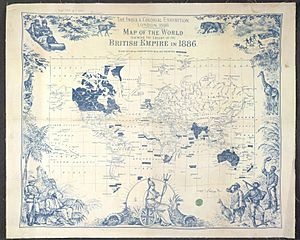Colonial and Indian Exhibition facts for kids
Quick facts for kids Colonial and Indian Exhibition |
|
|---|---|

The Queen Opening the Colonial and Indian Exhibition: Procession passing the principal entrance to the Indian Palace", The Illustrated London News, May 1886.
|
|
| Overview | |
| BIE-class | Unrecognized exposition |
| Name | Colonial and Indian Exhibition |
| Area | South Kensington |
| Visitors | 5.5 million |
| Location | |
| Country | United Kingdom of Great Britain and Ireland |
| City | London |
The Colonial and Indian Exhibition was a big event held in 1886. It took place in South Kensington, a part of London, England. The main goal of this exhibition was to help trade and make the different parts of the British Empire feel more connected.
The Prince of Wales said the exhibition would "stimulate commerce and strengthen the bonds of union." Queen Victoria herself opened the exhibition. By the time it closed, about 5.5 million people had visited it. The exhibition was held in special buildings that looked like Indian palaces.
Contents
What Was on Display?
The exhibition aimed to show off the many different lands that were part of the British Empire. Each area brought unique items to share.
New Zealand's Exhibits
New Zealand had a special area at the exhibition. They showed off items made from native woods. There was also a fernery, which is a garden for ferns.
- A display of frozen mutton (lamb meat) showed their growing farming businesses.
- A large Māori collection was also featured. This included a pātaka (a traditional Māori storehouse) and a tomb of a Ngati Pikiao chief.
- Paintings of Māori people by Gottfried Lindauer were shown.
- A fine art section had over 100 paintings, mostly showing New Zealand landscapes. One famous painting was The Haunt of the Moa, a Scene in a Puriri Forest by Kennett Watkins.
Other Interesting Displays
Many other parts of the Empire sent items for the exhibition.
- From the Lagos Colony (now part of Nigeria), a special ceremonial sword was displayed.
- The Straits Settlements (parts of Southeast Asia) sent a grasshopper swatter.
- A painting called After A Norther by Albert Bierstadt was shown in the West Indian gallery. This painting showed the Bahama Islands and was admired by the Prince of Wales.
Indian Art and Craft
The Indian section was very large and showed art from many different princely states.
- A grand gate from Jaipur, India, was built and sent by the Maharaja of Jaipur.
- Another gate, the Gwalior gateway, had been shown before at the Calcutta International Exhibition in 1883. It was loaned by the Victoria and Albert Museum.
- Many Indian artisans (skilled craftspeople) were at the exhibition. They showed how they made their beautiful works. These artisans were there to demonstrate their traditional skills.
What Happened After?
Some parts of the exhibition can still be seen today.
- The Jaipur Gate, which was built for the exhibition, was restored in 2004. You can now see it at the Hove Museum and Art Gallery.
- The Durbar Hall, another grand display from the exhibition, is now at the Hastings Museum and Art Gallery.
Images for kids




